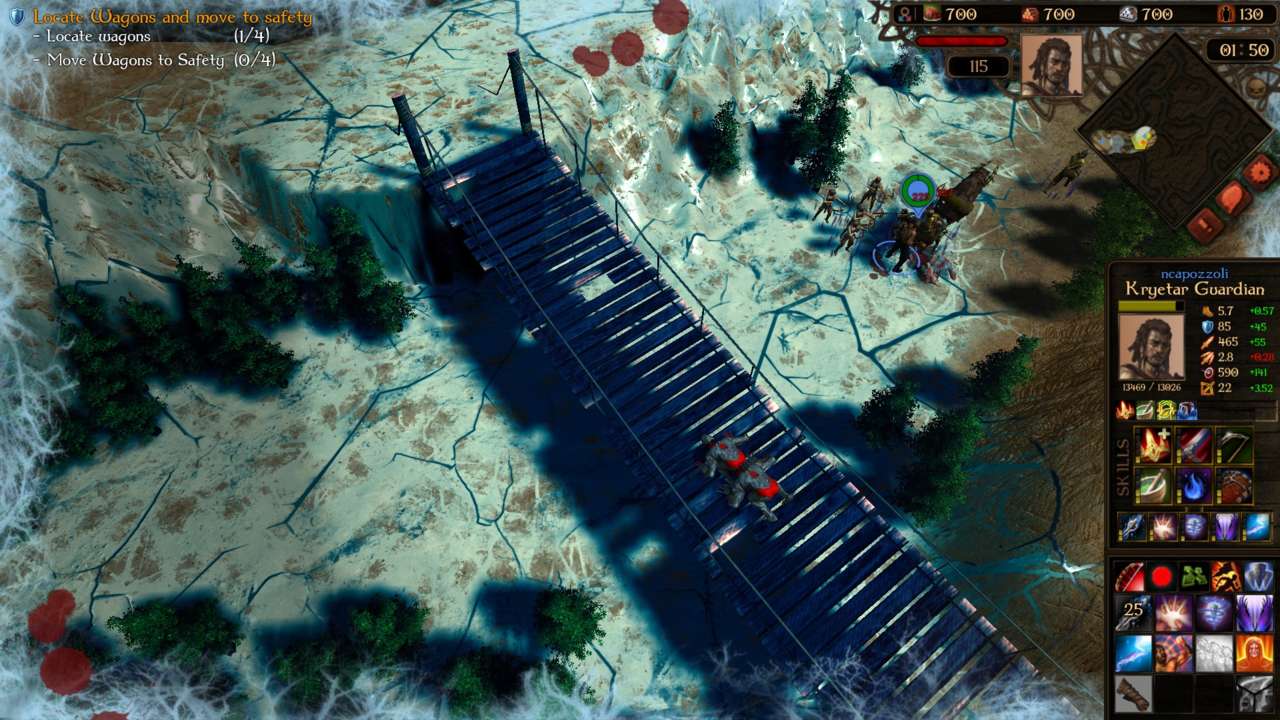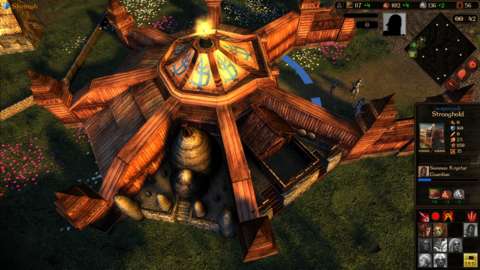The distinguishing feature of a desert isn't sand, or heat, but absence. It's one of those fussy middle school factoids that's only good for annoying others; nobody wants to hear your protestations about Antarctica's low annual precipitation at Pub Trivia Tuesday. But it comes to mind when roaming through Amorra, the setting of the real-time strategy game Frozen Hearth. Like the Antarctic, Amorra is an iced-over desert of absence. But where one lacks rainfall, the other is found wanting for other qualities. Like originality. Or creativity. Or technical competence. Or the artistic panache expected of a finished product. To play Frozen Hearth is to self-deprive, to go without the basic components of a healthy game ecosystem.
To be fair, desolation is central to Frozen Hearth's premise. The land of Amorra is besieged by the Shangur, a horde of demons not unlike Starcraft's Zerg race with an ice-themed makeover. The Shangur set about coating the realm in a deadly cold-creep, but an assemblage of feuding human clans set aside their differences to better oppose their shared foe. As one of the Avatars, tribal warriors who stand about twice as tall as an average person (eat your heart out, James Cameron), you lead the tattered remnants of humankind into desperate battle against the premature winter.

Frozen Hearth is a direct fusion of a traditional real-time strategy game and a multiplayer online battle arena of Dota's ilk. Armies are raised and trained, and directed across the hills and plains of miniaturized battlefields from on high. The goal is to destroy the enemy's stronghold--the base occupying the opposite corner of the symmetrical field of play. Avatars, for their part, function as the hero characters of Frozen Hearth's MOBA half, imbued with greater strength than a run-of-the-mill unit and a host of spells and abilities that can turn the tide of a skirmish. Avatars can gain experience and level up, unlocking or improving their abilities to heal or buff their allies, or attack or stun their foes. Stripped-down versions of base building and resource gathering round out the tactical provisions. Bases are limited to a single structure, divided into partitions for specialized renovations. Nodes that dot the map provide a steady drip of materials for units and upgrades, and a strategic objective for you skirmish over.
Another bit of middle school pedantry is the difference between "simple" and "simplistic"--one agnostic, the other damning. Games have long struggled to land on the proper side of that dividing line; sadly, Frozen Hearth veers in the wrong direction. It begins with a low-grade simulacra of other medieval fantasy strategy games, and only removes elements from the formula. Take the paring-down of traditional base-building mechanics, for example. It certainly simplifies the RTS, but it's also simplistic. There are only a few rote renovations that can be made, to be slotted into the preordained spaces of the larger structure. Without any territorial expansion, there's little reason to divide forces, save to briefly distract enemy forces. Nothing upends the core gameplay loop of spamming units and pointing them toward the nearest contested resources.
Avatars, for their part, function as the hero characters of Frozen Hearth's MOBA half, imbued with greater strength than a run-of-the-mill unit and a host of spells and abilities that can turn the tide of a skirmish.

It's here that I'd hypothetically point to the hybridization of the RTS and the MOBA as Frozen Hearth's finest touch. As the game's closest thing to an original offering, it's burdened with the responsibility of shoring up the otherwise dull experience. And perhaps it might have, were it not undermined by Frozen Hearth's variety of technical woes. The game is unusually taxing on a fairly robust system, regularly experiencing frame rate dips, screen tears, and janky miscellanea on medium settings. Unusual, because the game isn't much of a looker even when the graphics are turned up to eleven. The rudimentary units become indistinguishable when the action heats up, and the Avatars run the gamut from garden-variety shirtless warrior to humdrum hooded priest.
Units move over the terrain in a preternatural, detached glide--that is, when they're not vibrating ineffectually against each other like electronic football pieces. Sic too many on one foe, and the rest mill about absentmindedly when they can't find room to attack. Unchaperoned units wander off into enemy formations, seemingly on a whim. Pathfinding is unreliable; two adjacent units with the same destination often take different routes. There's no attack-move command, so should your units come under attack in the midst of their travels, they'll plod along heedlessly until they're killed. Many a campaign match is lost because a hero or a unit gets tragically separated from the group during a few seconds that it's unattended, usually a long way into a tedious, multistage battle of attrition that needs to be repeated in full should you fail in the home stretch. The unreliable mechanics suppress your ability to play the mind games that run astride better strategy titles; any time you lift your head up to survey the field, something goes wrong.
Intermittently it feels as if Frozen Hearth were conceived as a challenge to see which side could better shepherd its particular herd of cats. Or click on a singular desired unit out of a shapeless mass of like bodies. Or trick the artificial intelligence into a lapse of logic while the other side is preoccupied fighting against the unergonomic user interface or the uncomfortably close camera angle. It's a challenge, to be sure, but so is crossing the Sahara. The desert might even give more back.